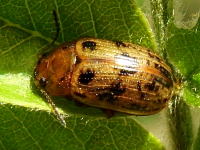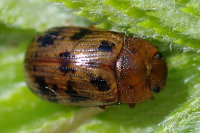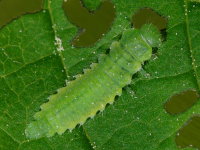Phylum Arthropoda (Arthropods) ➔ Subphylum Hexapoda (Hexapods) ➔ Class Insecta (Insects) ➔ Order Coleoptera (Beetles) ➔ Family Chrysomelidae (Leaf beetles)
Gonioctena (Goniomena) quinquepunctata (Fabricius, 1787)
Fünfpunktiger Blattkäfer
Synonyms and other combinations:
Chrysomela quinquepunctata Fabricius, 1787 |
Classification:
Gonioctena quinquepunctata belongs to the subfamily Chrysomelinae, tribe Gonioctenini.Distribution:
Scandinavia, Central and Southern Europe (in the south in mountains); east to the Russian Far East.Habitat:
Different habitats with suitable host plants.Description:
Length 4.5 - 8 mm; elytra with rather regular dot stripes, these on the upper side (rows 4-7) in front of the tip either perfectly regular or very little irregular; scutellum yellow or paler brownish; pronotum with coarse dots, more rounded at the front, widest behind the middle; mandibles not hollowed at the sides; last segment of the antennae long triangular, basal segment mostly relatively slender; only the tibiae of the middle and hind legs clearly spined.Elytra in female clearly chagrinated, dull; tip of aedoeagus asymmetrical in male.
A similar species is Gonioctena intermedia. On average, this beetle is slightly shorter in relation to its width and more arched. The males of both species can only be distinguished by the tip of the aedoeagus.
Biology:
Gonioctena quinquepunctata can be found on its host plants from April to August. The species lives on different plants of the rose family (Rosaceae), often on bird cherry (Prunus padus) and on mountain-ash (Sorbus aucuparia).The females produce a relatively small number of offspring. They are at least facultative ovovivipar. In ovoviviparous animals, the embryos develop in eggs that are still in the female body. The larvae hatch shortly after oviposition.
The larvae of Gonioctena quinquepunctata appear in April. They eat at the underside of leaves and go through 4 larval stages in 20 - 30 days. The fully-grown light green larvae pupate in the soil. After a pupal period of 15 - 25 days the new beetle generation hatches. In autumn the beetles undertake a maturation feeding and then go into the soil for hibernation.
Note:
The determination of the larva is not sure. Similar looking green larvae are also found in Gonioctena intermedia and Gonioctena pallida.References, further reading, links:
- Rheinheimer, Joachim, & Hassler, Michael: Die Blattkäfer Baden-Württembergs, 2018, 928 pages, Kleinsteuber Books (Karlsruhe), ISBN 978-3-9818110-2-5
- Arved Lompe: Die Käfer Europas - Ein Bestimmungswerk im Internet
- Agelastica alni
- Altica sp.
- Aphthona nonstriata
- Bromius obscurus
- Bruchus rufimanus
- Bruchus sp.
- Cassida nebulosa
- Cassida rubiginosa
- Cassida sp.
- Cassida stigmatica
- Cassida vibex
- Cassida vibex/bergeali
- Cassida viridis
- Chrysolina fastuosa
- Chrysolina haemoptera
- Chrysolina hyperici
- Chrysolina lucidicollis
- Chrysolina oricalcia
- Chrysolina sp.
- Chrysolina sturmi
- Chrysolina varians
- Chrysomela populi
- Chrysomela tremula
- Chrysomela vigintipunctata
- Clytra laeviuscula
- Clytra quadripunctata
- Coptocephala sp.
- Crepidodera aurata
- Crepidodera aurea
- Crepidodera fulvicornis
- Crioceris duodecimpunctata
- Cryptocephalinae sp.
- Cryptocephalus moraei
- Cryptocephalus nitidus
- Cryptocephalus pusillus
- Cryptocephalus sp.
- Donacia bicolora
- Donacia cinerea
- Donacia marginata
- Donacia versicolorea
- Galeruca tanaceti
- Galerucella s.l.
- Gastrophysa viridula
- Gonioctena decemnotata
- Gonioctena quinquepunctata
- Gonioctena quinquepunctata/intermedia
- Gonioctena sp.
- Gonioctena viminalis
- Lema cyanella
- Leptinotarsa decemlineata
- Lilioceris lilii
- Lochmaea caprea
- Neocrepidodera ferruginea
- Neocrepidodera sp.
- Oulema melanopus/duftschmidi
- Oulema obscura
- Pachybrachis sp.
- Phratora sp.
- Phratora vitellinae
- Phyllobrotica quadrimaculata
- Phyllotreta armoraciae
- Phyllotreta nemorum
- Phyllotreta vittula
- Plagiodera versicolora
- Plagiosterna aenea
- Plateumaris sp.
- Podagrica fuscicornis
- Psylliodes sp.
- Pyrrhalta viburni
- Sphaeroderma sp.
- Xanthogaleruca luteola


